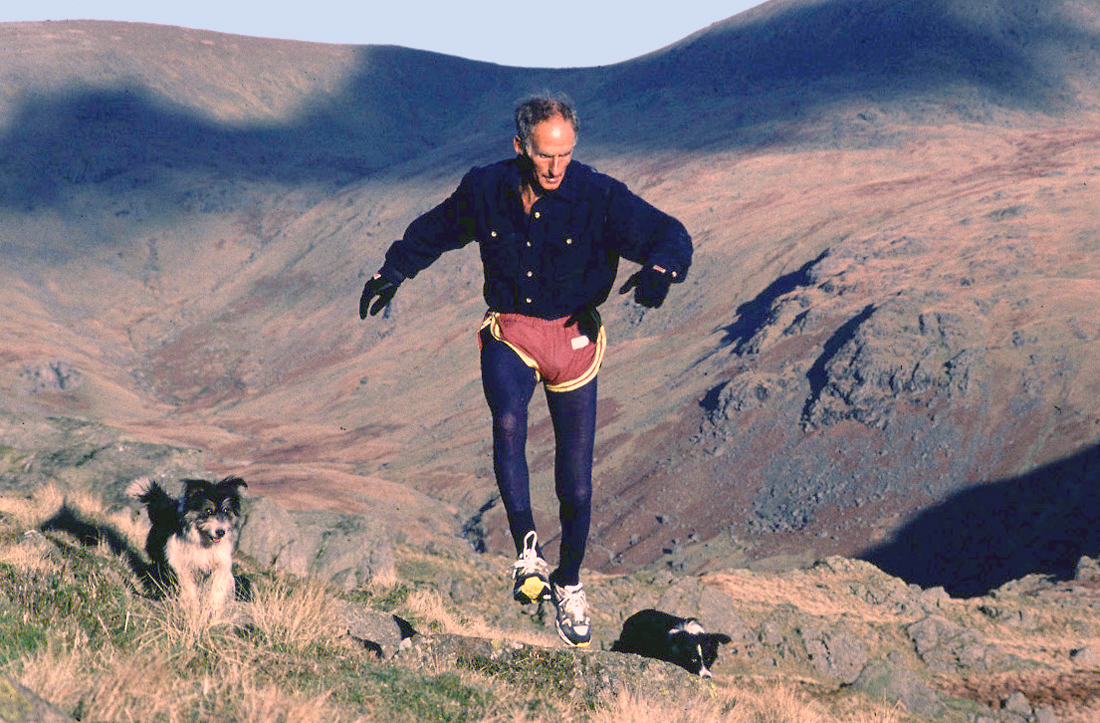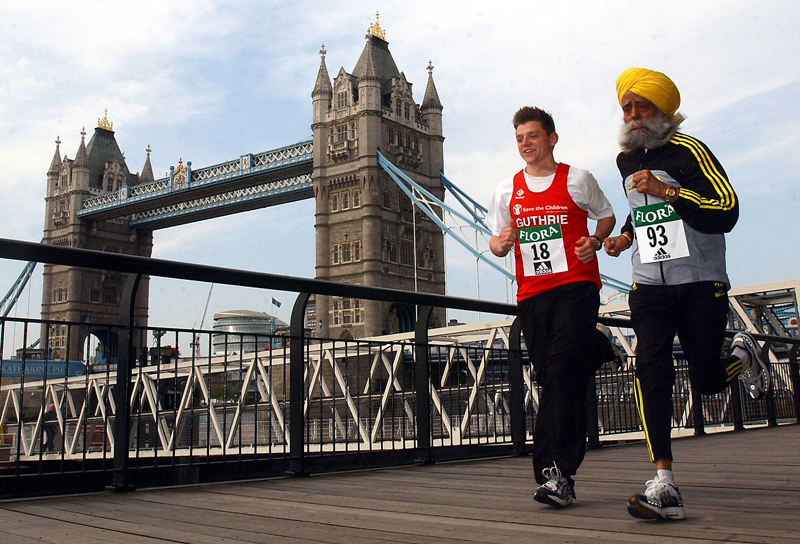The mechanism for the troubling fall in VO2max is not completely understood but is certainly due to more than one factor. A drop-off in cardiovascular capacity is a key culprit in the VO2max plunge, because ageing appears to be related to a steady downgrade in maximal heart rate. The popular formula for ’guesstimating’ max heart rate - 220 minus age - reflects this progressive fall in cardiac rate. Of course, lower heart rates can mean that less blood gets pushed through blood vessels to the muscles: for example (assuming the 220-minus-age formula is applicable), a 20-year-old endurance athlete could finish an intense bike race with ’top-end’ heart rates of about 195-200, while a 40-year-old competitor would struggle along with high-end rates of only 175-180; unless the older competitor was able to compensate for the rate fall-off with an increase in stroke volume (the amount of blood pumped per beat), he/she would be unlikely to keep up with the younger athlete.However, assuming equal levels of training, such stroke volume compensations are unlikely, since the heart tends to stiffen, fill in with connective tissue and become less powerful with ageing, and it therefore becomes harder to maximally fill the heart with blood. And one of the additional horrors of ageing is that blood vessels tend to become gradually more corroded and blocked by fatty deposits, which limits blood-vessel extensibility and carrying capacity.
The inevitable decline in VO2max does not hinge totally on the cardiovascular system, however. For one thing, muscle mass tends to decline with age, while total body fat simultaneously inches upwards. Since fat tissues produce no direct propulsive force, fat acts as a kind of ’dead weight’ underneath the skin, slowing performance. To give an example of the effects of increased body fat on performance, assume for a moment that a 154lb endurance runner with a VO2max of 60 and a marathon PB of 2:43:25 maintained his/her normal training levels but gained a little over four pounds of fat; such a fat acquisition would cause VO2max to plummet by 3% - and would tack almost five minutes onto marathon time. Any age-related loss in leg muscle mass would cause further decrements in performance.
In fact, since relative VO2max is expressed in terms of millilitres of oxygen consumed per kilogram of body weight per minute, and since muscle tissue utilises oxygen at higher rates than fat during exercise, one can readily understand that concurrent drops in muscle and increases in body fat would depress VO2max - and lead to losses in performance.
A vigorous training programme may partially arrest VO2max free-fall
The good news for endurance athletes is that maintaining a vigorous training programme may partially arrest this VO2max free-fall. The even better news is that there may be special strategies athletes can use to preserve as much as possible of their maximal aerobic capacities. The notion that strenuous exercise tends to halt VO2max erosion originated in a study carried out by Dr Greg Heath and co-workers at the Washington University School of Medicine in St Louis, Missouri. In this study, older athletes who maintained constant challenging levels of training lost only 5% of their VO2max per decade, about half of the typical decline(1).However, critics of this study contended that it was not the exercise itself which produced this effect but rather the innate physiological superiorities of the study participants, which allowed them both to resist ageing and to carry out rugged and regular exertions. The fallacy of this criticism had actually been demonstrated several years before Heath’s study, however, in a piece of research which involved re-testing 13 Olympic competitors and world champions 27 years after they were initially studied at the Harvard University Fatigue Laboratory in Cambridge, Massachusetts(2). The former champions in this investigation exhibited a VO2max nosedive of 1.06 ml/kg/min per year, which was actually much greater than the decline commonly observed in inactive people. Possessing world-champion physiological traits is therefore no protection against the ravages of the ageing process.
Lack of systematic exercise is key to major fitness decline in great athletes
The key to the large fitness fall-offs among the great athletes seemed to be their lack of systematic exercise; most of the champions had stopped training entirely during the 27 years since the initial study. Interestingly enough, one of the subjects, a former world record-holder named Fred Wilt, had continued to train and compete over this period, and his VO2max reduction was only 0.41 ml/kg/min per year - less than half the rate of decline experienced by his more slothful peers.Arguably the ultimate study on VO2max and ageing was performed by (and on) the legendary exercise physiologist David Bruce Dill, who was one of the principal researchers in the Harvard study described above. Dill was the research director of the Harvard lab from the time it opened in 1927 until it closed in 1947, and his classic textbook, Life, Heat, and Altitude, was an enormously important early contribution to the field of exercise physiology. Dill tested himself regularly in the laboratory from the age of 37 until he died, aged 93; in this 56-year span his VO2max went south at an average rate of only 0.23 ml/kg/min per year - an amazingly slow decline(3). Dr Dill was noted for his incredible level of regular physical activity, which included - as he grew older - prolonged bouts of fast-paced desert hiking!
In 1987, a year after Dill’s death, Dr Michael Pollock and co-investigators at the Mt Sinai Medical Center in Milwaukee, Wisconsin, reported an astonishing finding which lent further credence to the idea that very strenuous exercise was a VO2max preserver: well-trained, competitive endurance athletes with an average initial age of 52 were able to totally maintain VO2max values over a 10-year period(4)!
In the full group of 24 athletes studied by Pollock and crew, VO2max went into a tailspin averaging 9% during the decade of study. However, Pollock learned that some of the 24 athletes had continued to train vigorously and be competitive during the 10-year study, while others had become quite sedentary; and when he split the analysis, he found that the more active athletes had absolutely maintained their average VO2max at a steady 54 ml/kg/min - despite decreases in their maximal heart rates - while the less active ones had seen their VO2max values plummet by 12%.
Marc Rogers followed Pollock’s landmark study with an intriguing investigation which followed 18 well-trained veteran athletes and 14 age-matched lean, healthy, inactive control subjects(5). Both groups were free of hypertension, coronary artery disease and diabetes - conditions which are associated with the ageing process. The veteran athlete group included national-calibre competitors as well as the best older athletes in the St Louis, Missouri area.
In this study, the inactive controls experienced a 12% decline in VO2max per decade, while the veteran athletes, who maintained a relatively stable training programme, exhibited only a 5% depreciation in VO2max - exactly what Heath had observed in the first-mentioned study(1). On the basis of this research, Rogers concluded that about half of the deterioration in an average person’s aerobic capacity is due to the ageing process, while the other half is due to inactivity.
There is great variation in the rate at which very active individuals (eg athletes) lose VO2max, however, raising the possibility that some workout strategies might be better than others for preserving aerobic capacity in veteran athletes.
Rogers’ data shed some light on this question: the typical athlete in his active group completed the equivalent of about 200 miles of biking per week at the age of 50; 10 years later, this athlete was covering the equivalent of about 160 miles of bicycling per week, and average training intensity (the movement speed attained during workouts) was down by about 7-10%. Such an athlete typically lost about 5% of aerobic capacity during the 10-year study period.
A veteran athlete who maintained training preserved vo2max entirely
At the fairly inactive end of Rogers’ athletic group, the losses in VO2max were greater. Two athletes who cut training volume by 30% or more experienced VO2max losses of about 1% per year. By contrast, a 55-year-old, national-class athlete, who completely maintained the quantity and quality of his training, preserved all of his VO2max - and actually improved his competitive performances - over the entire study period! Such perfect preservation of aerobic capacity by very hard-working veterans was, of course, the same finding made by Pollock in his 10-year study.Overall, the research suggests that the received wisdom that inactive people lose about 10% of aerobic capacity per decade is on target. It also suggests that individuals who train regularly will lose only about 5% of VO2max per decade. However, such people generally reduce the quantity and quality of their training, which means that a proportion of this 5% loss is due to the inability to perfectly maintain top-level training programmes. Indeed, in a follow-up to his original investigation, Pollock pointed out that one of the most difficult problems faced by veteran athletes is simply the near impossibility of sustaining very high-quality training over a period as long as ten years, especially when the body is beginning to show signs of ’wear and tear’(6). It is not that veterans can no longer plan and carry out very rugged training sessions; rather that the physiological recovery processes may slow with age, thus increasing the risk of injury and lowering the actual frequency of torrid, fitness-maximising workouts.
What can you do to maintain aerobic capacity as the clock keeps running?
Clearly, though, some veterans are able to pull it off, as the research described above makes clear. So what are the secrets of such athletes? What can you do to hang on to all the aerobic capacity you currently have - or to even boost it a bit - as your clock keeps running?In an effort to find the answers to these questions, researchers from California State University and the University of Southern California followed 86 male and 49 female veterans over a 14-year period(7). At the beginning of the study, the average age of the male participants was 54, and that of the females was 49. (The inclusion of women in this study was particularly important, since they had not been included in previous similar studies). All the subjects had been training for at least five years and competing at least once a year, and none had a history of heart attack, coronary artery disease, cardiac arrhythmia (abnormal heart beat) or uncontrolled hypertension. For the purposes of the study, they were divided into 10-year age groups: female 40-49, 50-59 and 60+; male 40-49, 50-59, 60-69 and 70+.
All seven groups lost VO2max during the study period, and maximal heart rate also declined in most groups, with no major differences between men and women. However, these losses were not unexpected, since most of the groups reduced training volume during the study period, and even 20-year-olds will experience VO2max decay if they reduce training volume. The key question, then, was not why VO2max fell but which factors were associated with the best-possible preservation of VO2max.
For males in this study, the best way to sustain VO2max was to maintain or increase lean body mass (eg muscle tissue) and avoid increases in body fat. In fact, this proved more important than maintaining training volume for sustaining VO2max in male veteran athletes. This is a logical finding: after all, muscle tissue has an incredibly high oxidative capacity compared with other tissues in the body, and augmentation of body fat drives down relative VO2max by increasing the value of the denominator in the VO2max formula (ml/kg.min).
Among female veterans, the story was rather different. Body-mass factors were less important, possibly because the women were not very lean to begin with (about 20-27% body fat compared with 15-19% for men). For these women, the best ways to hold on to VO2max were to avoid reductions in training volume and - after menopause - to use hormone-replacement therapy (HRT). The former finding - that continuation of good training helps preserve VO2max - is not surprising; the latter finding relating to HRT was not well understood by the California researchers, but several studies have linked high oestrogen levels with positive adaptations to physical training. We are not recommending automatic hormone-replacement therapy for female athletes after menopause, however, since there are many reasons why women would want to think twice about such an intervention.
Here, then, are the take-home lessons of the studies on VO2max and ageing:
1. Maintain training. If you are a veteran athlete who wants to preserve VO2max, it is important for you to maintain the quantity and quality of your training as you get older. If possible, you should also seek ways to gradually and carefully increase the average intensity of your training sessions, since a couple of key studies have shown that master athletes who are able to do this may maintain VO2max completely and even improve performances. If you are a veteran whose training has been rather low on the intensity scale, such an improvement in quality may reward you with some PBs.2. More muscle less fat. To preserve VO2max, maintain or increase your muscularity and avoid getting fat. Muscle tissue has a high demand for oxygen, while fat tissue is dead weight which drags relative VO2max down and hurts performances. Sport-specific strength training is the best way to optimise your muscularity, while a sensible diet which is moderate in fat content, adequate in protein and carbohydrate and not over-rich in total calories will help keep you slim.
3. Vary training. To hold on to VO2max, add special modes of training to your overall programme. Grinding away at your chosen sport (cycling, swimming, running, rowing, etc) is a good way to increase the risk of injury in veterans. Therefore, alternate your usual workouts with other kinds of sessions, which can help improve your performance while keeping injury at bay. For example, endurance runners might consider non-impact proprioceptive training to improve balance and running economy; running-specific strength training to upgrade economy and bolster basic foot speed; and high-quality bicycle training to enhance leg muscle power and lactate threshold. Such supplementary sessions would be very likely to improve running power and endurance capacity and thus hike average oxygen consumption during workouts, stimulating VO2max to stay at stellar levels.
4. Work on lactate threshold. To maintain high-level performance, work on other factors besides VO2max in your training. For example, lactate threshold has been found to be much more responsive to training in older athletes than VO2max, perhaps because lactate threshold is more dependent on muscle function than on cardiovascular attributes per se. Thus, veterans who lose some VO2max might be able to preserve - or even improve - performance by making major improvements in their lactate-threshold development.
5. Use key workouts. To support VO2max and lift lactate threshold simultaneously, use key workouts such as fartlek sessions. While the thought of fartlek work conjures up images of Finnish skiers gliding through forests and Kenyans running with amazing speed along the highlands of western Kenya, fartlek-type efforts are perfect for veteran athletes. Whether you are biking, swimming, rowing, running, speed-walking or engaging in some other form of endurance activity, a very nice fartlek workout would involve warming up thoroughly and then alternating 2-5-minute bouts of working at 90-100% of max capacity with 1-4-minute intervals of easier (recovery) movement until significant fatigue develops.
The bottom line? You can’t keep the ageing process at bay forever, but if you train smart and stay away from injury, you should be able to hold your VO2max decline to less than 0.5% per year as you move into your fifth decade of life - and beyond.
Owen Anderson
References
1. Journal of Applied Physiology, vol 51(3), pp 634-640, 1981
2. Journal of Sports Medicine, vol 7, pp 4-32, 1967
3. Running Research News, vol 6(5), pp 1, 4-6, 1990
4. Journal of Applied Physiology, vol 62(2), pp 725-731, 1987
5. Journal of Applied Physiology, vol 68(5), pp 2195-2199, 1990
6. Journal of Applied Physiology, vol 82, pp 1508-1516, 1997
7. Medicine and Science in Sports and Exercise, vol 33(10), pp 1744-1750, 200










